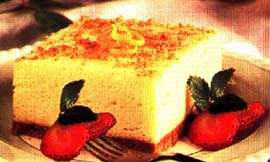|
|
Easy
Lemon Dessert

Ingredients:
1-1/2
cup graham crumbs
4 tablespoons butter or margarine, melted
3 tablespoons sugar
Filling:
1 pkg.
(85 g) lemon jelly powder
1 cup boiling water
2/3 cup evaporated milk
1 pkg. (250 g) cream cheese, room temperature
1/3 cup sugar
Garnish:
1 cup
fresh strawberries
Makes 8 to 10 servings.
Preparation:
- Combine crumbs, butter and
sugar. Press onto bottom of 9-inch
square baking dish, reserving 3 tablespoons crumb mixture for top.
- Dissolve jelly powder in
boiling water. Cool to room temperature.
- Pour evaporated milk into
plastic bowl and chill in freezer
about 25 to 30 minutes.
- In a large bowl beat together
cream cheese and sugar. Gradually
stir in jelly.
- Beat chilled evaporated milk
until stiff, about 1 to 2 minutes
and fold into cream cheese mixture.
- Pour mixture over crumb crust,
sprinkle with reserved crumbs
and refrigerate until set.
- Garnish with fresh strawberries.
|
|
Did You Know?
|
The lemon is a small
evergreen tree (Citrus limon) originally native to Asia, and is also
the name of the tree's oval yellow fruit. The fruit is used for
culinary and nonculinary purposes throughout the world – primarily for
its juice, though the pulp and rind (zest) are also used, mainly in
cooking and baking. Lemon juice is about 5% (approximately 0.3 mole per
liter) citric acid, which gives lemons a tart taste, and a pH of 2 to
3. This makes lemon juice an inexpensive, readily available acid for
use in educational science experiments. Because of the tart flavor,
many lemon-flavored drinks and candies are available, including
lemonade.
The lemon was first recorded in literature in a tenth century Arabic
treatise on farming, and was also used as an ornamental plant in early
Islamic gardens. It was distributed widely throughout the Arab world
and the Mediterranean region between AD 1000 and AD 1150.
Lemons entered Europe (near southern Italy) no later than the first
century AD, during the time of Ancient Rome. However, they were not
widely cultivated. The first real lemon cultivation in Europe began in
Genoa in the middle of the fifteenth century. It was later introduced
to the Americas in 1493 when Christopher Columbus brought lemon seeds
to Hispaniola along his voyages. Spanish conquest throughout the New
World helped spread lemon seeds. It was mainly used as ornament and
medicine. In 1700s and late 1800s, lemons were increasingly planted in
Florida and California when lemons began to be used in cooking and
flavoring.
In 1747, James Lind's experiments on seamen suffering from scurvy
involved adding Vitamin C to their diets through lemon juice.
|
|